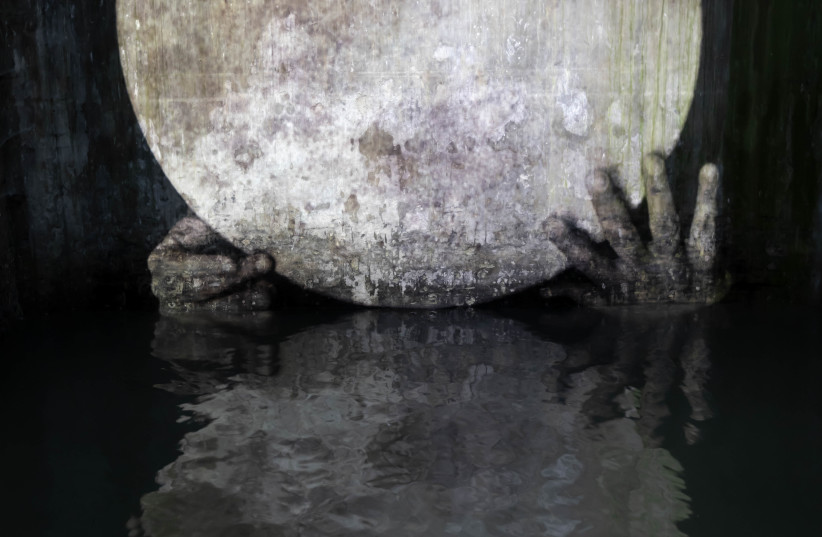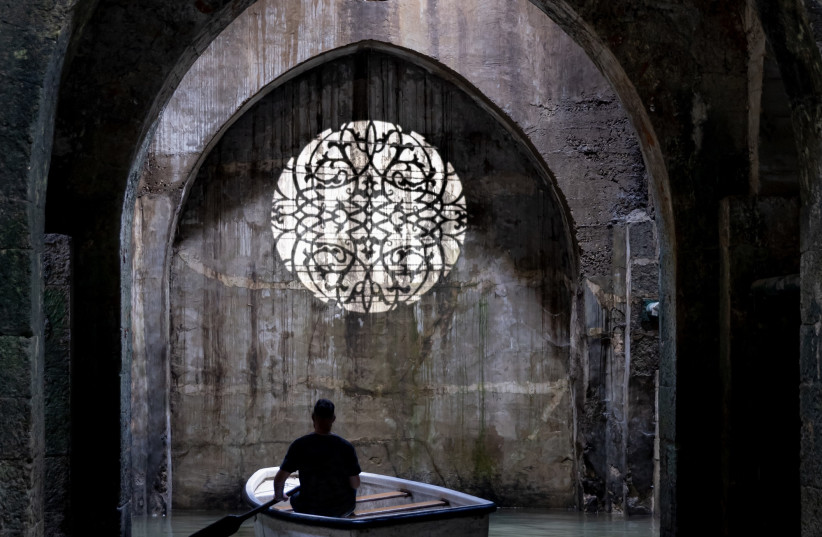When I cycled over to Ramle a couple of months ago, summer was still young and the daily temperatures climbed incessantly to the mid-30s. What joy, then, and relief it was to descend the steps of a heftily constructed eighth-century building with Dor Zlekha Levy to get an eyeful and earful of his video and sound installation at the Pool of the Arches.
The expansive site-specific work, which goes by the eminently appropriate title of Reflection, is the first of its kind to grace the subterranean pool that has existed since 789 CE, when the Muslim authorities incorporated it into the local water supply system.
“There was a sort of reservoir here,” Levy explains. “It wasn’t drinking water. It was water for animals or for irrigation.”
Over 1,200 years of history in Ramle
There are over 1,200 years of history there, and, intriguingly, the pool predates the severe earthquake of 1068, when large parts of Ramle were decimated. Some of that temporal underpinning resonates – audibly and emotionally – in Reflection. It is curated by Smadar Sheffi under the aegis of the Contemporary Art Center Ramle (CACR), which she founded and still serves as its chief curator, as well as of the Ramle Municipality and Ramle Foundation.
Both Levy and Sheffi have a history of digging into the past, and of exploring and marrying different cultures, often in historic buildings.

Over the past six or seven years, Levy has produced a string of fascinating audiovisual installations, video art, and live performances with sound at their core. He has exhibited at the Tel Aviv Museum of Art; the Israel Museum; Kunsthalle in Stavanger, Norway; Kadist in Paris; and the Institute of Contemporary Arts (ICA) in London. Along the way, he has picked up a clutch of official slaps on the back, such as the Zoom Prize for a Young Israeli Artist in 2016, and the Culture Ministry Prize for a Young Artist the following year. He also spends part of his waking hours lecturing at the Bezalel Academy of Arts and Design.
AS WE navigate the drop down into the subterranean reservoir, we leave the baking summer heat behind and enter a different world of multisensorial elements. The touch of the solid stone walls is a balm to my well-heated cyclist’s hands, and the sudden sharp rise in the moisture content of the still air adds to the ambiance transition. Then the ears get in on the sensory act, and the sound of gently lapping water is overlaid by a beguiling multi-stratified musical garnish.
The alluring plaintive vocal and instrumental airs come at you from all angles. The music clearly fits the atmospheric bill, as the liturgical and romantically inclined songs pervade the consciousness. The centuries-old works, sung in Arabic and Hebrew, supported by frame drum percussion and mellifluous oud plucking, filter through an elaborately constructed amplifier system, with speakers strategically positioned around the cavernous interior.
Then comes the fun part as Levy and I step into a rowboat and begin to make our way around the pool. It is a delightful and charming experience on all counts.
In a non sequitur, I suddenly think that we could all save ourselves a lot of time and hard-earned cash by popping over to Ramle to escape the seemingly interminable summer heat instead of all that bother involved in flying to foreign climes. It could be a fun, inexpensive and enlightening alternative to the increasing trials of international travel, and surely better for our fragile ecology.
Green thoughts were soon banished by the bewitching soundtrack to Reflection as delectable works – such as “Yaallah,” scripted by 17th-century Damascus-born poet, biblical commentator, Kabbalist and rabbi Israel ben Moses Najara, fellow Syrian-born 19th-century poet and rabbi Raphael Antabi’s “Lama Haketz?” (Why the End?) and a couple by unknown writers, in Hebrew and Arabic – imbued the location with an almost pungent magic.
The seductive vocals of Yahala Lachmish, Dema Kablan and Gil Rabi, supported by percussionist Roei Friedman and oud player-arranger Yaniv Raba, eddied and intertwined as we floated – physically and metaphorically – around.

FOR LEVY, Reflection has been a long time in coming.
“I first came here when I was a kid, with my family. I can’t even remember when that exactly was,” he says. The place made a lasting impression on the youngster. “I remembered it.”
It also helped that, thanks to his Iraqi-born grandparents, the music was always there in his formative years. He began to make something of that cultural baggage. “I think that state of mind, coming from the worlds of Hebrew and Arabic culture, and being connected to Jewish life, that is something that informs my work in general.”
He started to put that into practice as an art teacher diploma student, and that takes pride of place in Reflection.
“In the pool, basically, you float through a musical composition,” he says, “and between languages. You hear Hebrew from some of the speakers and Arabic from the others.”
It makes for a confusing yet stimulating experience as the voices mesh and bifurcate. “In places in the pool, you can hear them at the same time. You hear the same tune, between different languages.” It certainly gets you thinking, and feeling.
Levy makes the most of the location and its special aesthetics and acoustics. “Sometimes the Hebrew and Arabic sound very similar, and it is hard to differentiate between them because of the sound conditions of the pool, with the accentuated reverb. It is sometimes hard to discern if you are listening to two voices or one.”
THAT CONJOINING element, says Sheffi, lies at the core of the work and is central to her own line of thought about how she goes about her curating business in Ramle, through the CACR. She points out the intercultural essence of the mixed Jewish-Arabic city and how that is reflected in the artistic ventures she promotes there. “Common denominators are a part of the program. Ramle generally works in a pragmatic way. There are problems here, but the city works well, and relationships [between Arabs and Jews] are ongoing.”
That also came through in the preliminaries for Reflection.
“When we wanted to write texts in Arabic, we went to the local mosque to make sure we had the spelling right in the invitation and the material that goes with the installation,” Sheffi notes.
“When we wanted to write texts in Arabic, we went to the local mosque to make sure we had the spelling right in the invitation and the material that goes with the installation.”
Smadar Sheffi
That mutual acceptance and respect ethos proved to be invaluable last year when, following increasing political tension during Ramadan, riots broke out across the country, including in Lod, Ramle and east Jerusalem. Sheffi says the generally healthy relations between local Jews and Arabs helped to assuage much of the violence. “The first Friday after the riots broke out, the mayor of Ramle and the head of the Wakf walked together in public, and they had an outdoor dinner together on Bialik Street [one of the city’s main streets]. They said the violence should stop because they don’t want the city to be ruined.”
Sheffi says her arts center is evidence of the generally harmonious way of life in Ramle. “We have a glass-fronted balcony at the CACR building, but it wasn’t touched.”
She believes Reflection is part and parcel of that peaceful outlook, although adding that she is not looking to lay down the law to anyone. “We are not interested in coercing reality. The pool is an amazing place.” It certainly is.
She says she was partly drawn to Levy’s installation because of its wide appeal. “This is the first CACR work at the Pool of the Arches, and I could have taken something from a big-name artist. Believe me, I had plenty of offers.” I believed her. “I was looking for something more universal.” Sheffi wants us to consider the bigger picture. “Some of the artists I thought about wanted to show Ramle in Ramle. There’s no point to do that. You can just step outside and look at what there is there.”
Sheffi sees Reflection as feeding off the broad spectrum of age-old Jewish and Arabic culture and tradition. And she has the proof of that philosophical pudding. “I once saw some religious Jewish people visit the place. They knew the piyutim (liturgical songs) and sang them. I loved it. There was also a family from Jerusalem, with lots of kids with no interest in art. So I gave them a copy of the song booklet [of Reflection]. They opened it and were so happy to see the words. They knew the songs and the music.”
Reflection gestated for quite a while, with the preparation process stretching out to a full three years. Naturally, the coronavirus era impinged on progress, but the installation was thoroughly worked through – and there were plenty of taxing technical logistics involved – before going underground.
Levy goes along with the live and let live ethos. She says it is sewn into the aural fabric of the creation. “The paytanim or paytaniyot (liturgical singers) sing based on the Eastern pronunciation.” That includes the guttural letters, such as het and ayin, which add to the common sonic ground between Hebrew and Arabic. “The melody [of the Arabic and Hebrew versions of the piyutim] is exactly the same, and the music works the same way.
“When you float around in the pool you are, ostensibly, between two different things from Arabic and Jewish cultures. But this situation whereby you have two cultures, two languages, two voices in the same space, that is what I am talking about. This is not a situation of enemies on opposite sides of a wall, with two opposing voices on either side. These are internal voices that resonate inside you.”
Levy has also done his best to make the visual stratum of the installation as engrossing and enticing as possible. The video image of the frame drum on one of the pool walls is nothing short of hypnotic. The two hands look like celestial bodiless limbs emerging from the rippling water and, from certain angles, come back at you from the water. The oud portrayal is just as compelling. We see the strings vibrating from inside the body of the instrument, filmed via a minuscule camera inserted by Levy. That is a mesmerizing experience and helps to draw the observer-listener into the inner dynamics of the work.
There is much in the way of ebb and flow to Reflection, on physical, emotional, cultural and other levels.
Arabic music is based on a modular format incorporated in the maqam structure. Levy notes that the singular form “maqam” can be interpreted in several ways. “It is not just the system of musical scales. It means mood and all sorts of things. I felt the music is a sort of compass searching for itself.”
That ties in with Levy’s familial backdrop. “That references physical migration but also studying Eastern music from a Western perspective, things that are lost in translation, and focusing on the note that starts the maqam. I felt that suited this place,” he says.
Reflection closes in June 2023. For more information: www.goramla.com
